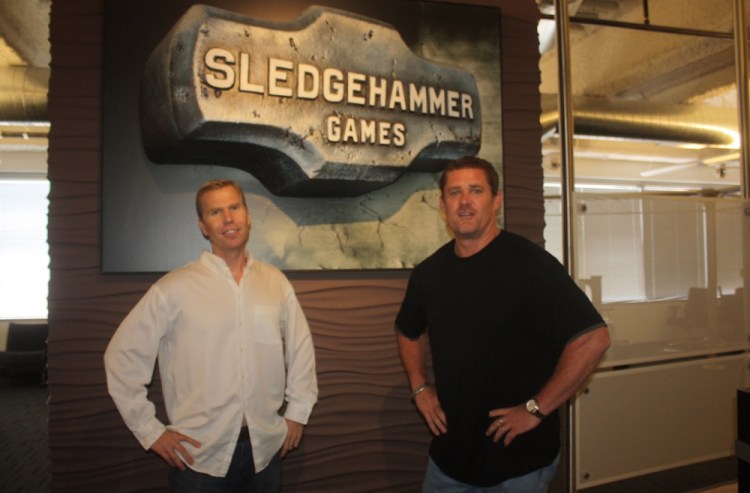Building Sledgehammer and Advanced Warfare
Meanwhile, Sledgehammer was hiring people from major game studios such as Visceral (Dead Space), Valve (Half-Life, Portal, Dota 2), Naughty Dog (Uncharted, The Last of Us), Crystal Dynamics (Tomb Raider), and EA. That included Dead Space veterans like art director Joe Salud and Aaron Halon, the director of product development.
“We wanted to get like-minded people, people who cared about the franchise,” Halon said.
The first year of preproduction was hard because so many of the new employees were new. Some people were inclined to do what they did before; others wanted to break all of the rules.
“From a team dynamic standpoint, it could be a frustrating challenge,” Salud said. “For the first year we’re saying, ‘Where are we going?’ We were trailblazing. It was exciting, but at the same time very frustrating.”
Fortunately, the technology of the next-generation game consoles, based on x86 processors from Advanced Micro Devices, was familiar because it was the foundation for PC games.
“Globally, it had pluses and minuses as well, and expectations. It takes us a while to fully understand what the hardware is capable of,” Halon said.
They dwelled on making the graphics for the PlayStation 4 and Xbox One versions as good as possible. Among the tasks: Capturing the performance of actors so completely that it seemed like the animated human faces in the game were really like videos of human faces. Call of Duty has always pushed the edge on technology, but they often make a trade-off for the sake of preserving speed in the combat. But in this game, the developers felt they didn’t have to make that trade-off.
“We’re trying to cross the line of what’s believable and realistic,” Salud said. “We’re trying to immerse you more. One of the visual tools for doing that is fooling your eye into thinking you’re there. Giving you at least that impression. If that impression comes through, you’re not going to be concentrating on the graphics so much. You’ll just enjoy the experience. You’ll feel like you’re really there.”
That level of realism also forced the team to take the rest of the environment, like the area around the Golden Gate Bridge, more realistic.
“We had the art team go out to the Golden Gate Bridge and do a lot of color grading tests,” Halon said. “For other, more exotic locations, we would find proxies. We’d go on a ship or something like that for things like the later part of the San Francisco levels.”
Fortunately, Activision decided to give Sledgehammer as high of a budget it needed to do this.
Making the future believable
Condrey said that the team also had to make sure that its technology of 40 years in the future had to be grounded in today’s reality of military research. Some things were totally unbelievable, so the team took it out. One example: a teleportation grenade. It could transport you instantly. But it doesn’t exist.
But they did include military realities like drones, vertical wall climbing, directed energy weapons, hover tanks, hover bikes, “smart grenades,” and heavily armored soldiers who guard checkpoints.
“The U.S. government just started speaking publicly about something called the Talos project, which is essentially an armored exo soldier of the future,” Condrey said. “They say it’s battlefield ready in two years. It’s working now. If you look up the Talos system, it’s like the AST. A little smaller.”
An AST is truly a tank-like character. It’s a lot like a mech, but it clearly resembles a soldier from today, rather than something fanciful from the future.
Salud said that the team tried to make everything look like it was based on today’s reality.
“Everything goes back to what is relatable,” he said. “The design of it, there’s a couple of layers in there, but it boils down to everything being based on function. What’s it supposed to do? Then we think about, okay, what technology is currently out there? Then we extrapolate from that. Especially for the exo, we’ve talked to military advisors. We’ve hired concept designers who have worked on things like this before.”
The environment of the future is deadlier than ever. That means that expert players will be able to take out new players more easily than ever. The designers recognized that and made sure there was a foil for every powerful weapon.
As far as the difficulty goes, Schofield said, “We think we made a game for everybody. So many people will play one game a year, and it’s this game.”
“Part of the experience is about mastering the game. For some, this is their first Call of Duty. It has to be a great introduction to the experience, and something challenging for the experts,” Condrey added.
We’ll find out soon just how good a job Sledgehammer did with its extra year of development time. Activision will reveal multiplayer details soon, and the game will all platforms at once in November. However it turns out, Sledgehammer has had a very unique journey as a brand new studio in charge of a AAA game franchise. But it’s already clear that the founders and developers have poured their heart and soul into this project.

VentureBeat's mission is to be a digital town square for technical decision-makers to gain knowledge about transformative enterprise technology and transact. Learn More



